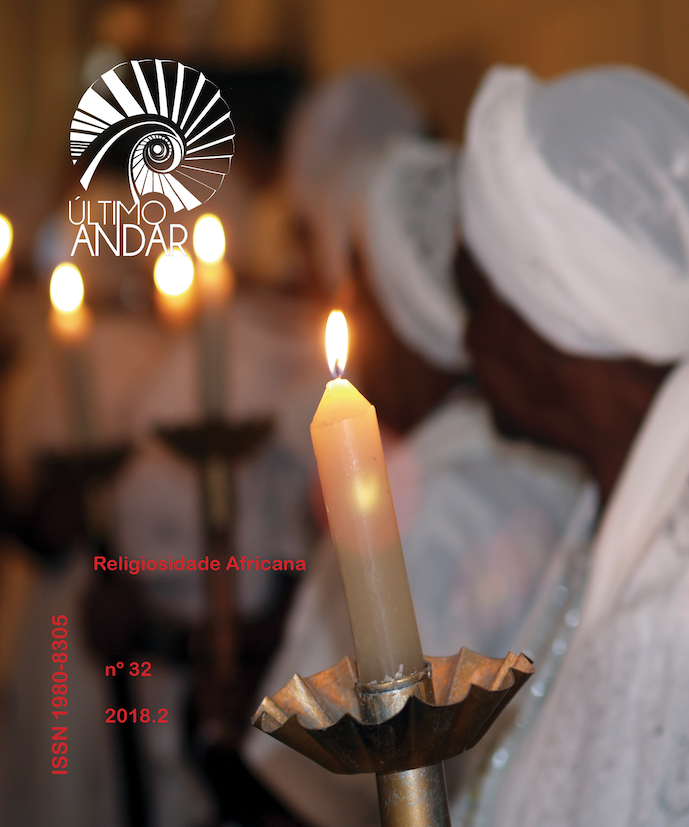EAT AND PRAY: THE ROLE OF FOOD PRACTICES IN THE STUDY OF RELIGION
DOI:
https://doi.org/10.23925/1980-8305.2018i2p111-122Keywords:
alimentação e religião, estética da religião, religião, sentidos, paladar nas religiões.Abstract
Among many possible approaches in studying religion, one can find the aesthetics of religion, a field that searches comprehension through the senses. This paper questions why not use the senses rather than textual sources as evidences for the religious studies, though the main focus lies in the study of food practices and taste issues as tools for religious studies, since every religion has a say on food practices or uses food to specific goals. A hierarchy of senses leaves taste behind and added to that a “protestant” approach to studying religion clouds many possibilities of using senses, specially taste and smell, as evidence sources of religious experience, although “all” religions have a say on food. A brief state of art, associated to few examples about the use of food in religions, as well as, mentioning scholars that are using the study of food practices to comprehend religious experience compose the argumentation of this paper.
References
"ALBALA, Ken. e EDEN, Trudy.(Org.) Food and faith in Christian culture. New York:"
"Columbia University Press, 2011."
"ALLEN, J. The omnivorous mind. Our evolving relationship with food. Cambridge: Havard University Press, 2012.
BANDLER, R. e GRINDER, J. A estrutura da magia. Rio de Janeiro: Guanabara Koogan S.A., 1977.
CAMARGO-MORO, F. Arqueologias culinárias da Índia. Rio de Janeiro, São Paulo: editora Record, 2009.
CORBIN, A. Saberes e odores. São Paulo: Cia. Das letras, 1987.
. Histoire et antropologie sensorielle. Antropologie et sociétés, 14 (2) : 13-24, 1990. CORBIN, A. COURTINE, J-J. e VIGARELLO, G. História o corpo. Rio de Janeiro: Vozes, 2009.
EZQUIBELA, I. J. Prescripciones y tabúes alimentarios: el papel de las religiones. In: Distribuicion y Consumo. Barcelona, Novembro-Dezembro, 2009.
FREYRE, G. Açúcar: Uma sociologia do doce, com receitas de bolos e doces do Nordeste do Brasil. São Paulo: Global, 2007.
GRESCHAT, H-J. O que é ciência da religião? São Paulo: Paulinas, 2005, p. 77. GRUMMET, David. e MUERS, Rachel. (Ed.) Eating and believing: Interdisciplinary perspectives on vegetarianism and theology. London: T&T Clark, 2008.
HARVEY, G. Food, Sex and Strangers. Understanding religion as everyday life. Durham: Acumen Publishing Limited. 2013.
. Respectfully eating or not eating. Putting food at the centre of religious studies. Turku, Finland: Scripta Donnerianni Instituti Aboensis, Religion and Food, Vol. 26, 2015. Disponível em: http://ojs.abo.fi/index.php/scripta/issue/view/74/showToc.
HOCK, K. Introdução à ciência da religião. São Paulo: edições Loyola, 2010. JAMAL, S. Aroma árabe: receitas e relatos. São Paulo: editora Senac São Paulo, 2005.
MONTANARI, M.(Org.). O Mundo na cozinha. História, identidade, trocas.São Paulo: Senac São Paulo, 2009.
NASCIMENTO, A. B. Comida: Prazeres, gozos e transgressões. Salvador: EDUFBA, 2007. ONFRAY, M. A Razão Gulosa. Filosofia do gosto. Rio de Janeiro: Ed. Rocco, 1999.
PASSOS, J. D. e USARSKI, F. (Orgs.) Compêndio de ciência da religião. São Paulo: Paulinas: Paulus, 2013.
PINHEIRO, R. Hábitos Alimentares. Salvador: Casa da Qualidade. 1999."
Downloads
Published
How to Cite
Issue
Section
License
The Authors maintain the copyright and grant the journal the right to first publication, with the work simultaneously licensed under the Creative Commons Attribution License that allows the sharing of the work with acknowledgment of authorship and initial publication in this Journal.
Authors are authorized to assume additional contracts separately, for non-exclusive distribution of the version of the work published in this journal (eg, publishing in institutional repository or as a book chapter), with acknowledgment of authorship and initial publication in this journal.
Authors are allowed and encouraged to publish and distribute their work online (eg in institutional repositories or on their personal page) at any point before or during the editorial process, as this can generate productive changes, as well as increase impact and citation of the published work.


